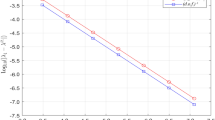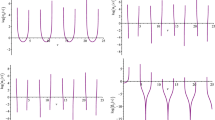Abstract
In simulating physical systems, conservation of the total energy is often essential, especially when energy conversion between different forms of energy occurs frequently. Recently, a new fourth order energy-preserving integrator named MB4 was proposed based on the so-called continuous stage Runge–Kutta methods (Miyatake and Butcher in SIAM J Numer Anal 54(3):1993–2013, 2016). A salient feature of this method is that it is parallelizable, which makes its computational time for one time step comparable to that of second order methods. In this paper, we illustrate how to apply the MB4 method to a concrete ordinary differential equation using the nonlinear Schrödinger-type equation on a two-dimensional grid as an example. This system is a prototypical model of two-dimensional disordered organic material and is difficult to solve with standard methods like the classical Runge–Kutta methods due to the nonlinearity and the \(\delta \)-function like potential coming from defects. Numerical tests show that the method can solve the equation stably and preserves the total energy to 16-digit accuracy throughout the simulation. It is also shown that parallelization of the method yields up to 2.8 times speedup using 3 computational nodes.






Similar content being viewed by others

References
Hairer, E., Lubich, C., Wanner, G.: Geometric Numerical Integration: Structure-Preserving Algorithms for Ordinary Differential Equations, 2nd edn. Springer, Berlin (2006)
Gonzalez, O.: Time integration and discrete Hamiltonian systems. J. Nonlinear Sci. 6, 449–467 (1996)
McLachlan, R.I., Quispel, G.R.W., Robidoux, N.: Geometric integration using discrete gradients. Phil. Trans. R. Soc. Lond. A 357, 1021–1045 (1999)
Quispel, G.R.W., McLaren, D.I.: A new class of energy-preserving numerical integration methods. J. Phys. A 41, 045206 (2008)
Hairer, E.: Energy-preserving variant of collocation methods. J. Numer. Anal. Ind. Appl. Math. 5, 73–84 (2010)
Miyatake, Y., Butcher, J.C.: A characterization of energy-preserving methods and the construction of parallel integrators for Hamiltonian systems. SIAM J. Numer. Anal. 54, 1993–2013 (2016)
Delfour, M., Fortin, M., Payr, G.: Finite-difference solutions of a non-linear Schrödinger equation. J. Comput. Phys. 44, 277–288 (1981)
Besse, C.: A relaxation scheme for the nonlinear Schrödinger equation. SIAM J. Numer. Anal. 42, 934–952 (2004)
Sanz-Serna, J.M., Verwer, J.G.: Conerservative and nonconservative schemes for the solution of the nonlinear Schrödinger equation. IMA J. Numer. Anal. 6, 25–42 (1986)
GitHub. (2019). https://github.com/mb4-nls2d/mb4-nls2d/tree/master/output/
GitHub. (2019). https://github.com/mb4-nls2d/
Hammock, M.L., Chortos, A., Tee, B.C.-K., Tok, J.B.-H., Bao, Z.: 25th Anniversary article: the evolution of electronic skin (e-skin): a brief history, design considerations, and recent progress. Adv. Mater. 25, 5997–6038 (2013)
Troisi, A., Orlandi, G.: Charge-transport regime of crystalline organic semiconductors: diffusion limited by thermal off-diagonal electronic disorder. Phys. Rev. Lett. 96, 086601/1-4 (2006)
Imachi, H., Yokoyama, S., Kaji, T., Abe, Y., Tada, T., Hoshi, T.: One-hundred-nm-scale electronic structure and transport calculations of organic polymers on the K computer. AIP Conf. Proc. 1790, 020010/1-4 (2016)
Hoshi, T., Imachi, H., Kumahata, K., Terai, M., Miyamoto, K., Minami, K., Shoji, F.: Extremely scalable algorithm for 10\(^8\)-atom quantum material simulation on the full system of the K computer. In: Proceedings of ScalA16: workshop on latest advances in scalable algorithms for large-scale systems, held in conjunction with SC16: the international conference on high performance computing, networking, storage and analysis, Salt Lake City, UT, USA (2016)
Terao, J., Wadahama, A., Matono, A., Tada, T., Watanabe, S., Seki, S., Fujihara, T., Tsuji, Y.: Design principle for increasing charge mobility of \(\pi \)-conjugated polymers using regularly localized molecular orbitals. Nature Comm. 4, 1691 (2013)
Tada, T.: Wave-packet multi-scale simulations based on a non-linear tight-binding Hamiltonian for carrier transport in \(\pi \)-conjugated polymers. Mater. Chem. Front. 2, 1351 (2018)
Acknowledgements
We thank the anonymous reviewer for carefully reading our manuscript and providing many insightful comments. We also thank Professor Takayasu Matsuo at the University of Tokyo for valuable discussion.
Funding
The present research was partially supported by JSPS KAKENHI Grant nos. JP16KT0016, JP16K17550, JP17H02828, JP17K19966 and JP19KK02555. The present research was partially supported by Priority Issue 7 of the post-K project.
Author information
Authors and Affiliations
Corresponding author
Additional information
Publisher's Note
Springer Nature remains neutral with regard to jurisdictional claims in published maps and institutional affiliations.
Appendix: The NLS-type equation arising from quantum wavepacket dynamics
Appendix: The NLS-type equation arising from quantum wavepacket dynamics
The target problem of the present paper stems from the quantum dynamics simulation of electronic wavefunction, so as to understand the electrical conductivity of organic semiconductor materials. Organic semiconductor materials form the foundation of flexible devices [12]. The conductivity is simulated by the time evolution of a charged ‘carrier’ with a wavefunction \(\varPsi ({\textit{\textbf{r}}}, t)\), for example, as in [13]. The carrier is classified into hole or electron, where a hole or electron is positively or negatively charged, respectively. The wavepacket is expressed by the linear combination of m given basis functions \(\{ \chi _i({\textit{\textbf{r}}}) \}_{i=1}^m\):
with a complex coefficient vector of \({\textit{\textbf{u}}}(t) \equiv (u_1(t), u_2(t),\ldots , u_m(t))^{\top }\). Hereafter we call m-site model, where a site represents, typically, a molecule or atom. The i-th component \(u_i\) (\(i=1,2, \ldots , m\)) indicates the amplitude on the i-th site and we assume that the weight of the carrier on the i-th site is written as \(n_i \equiv |u_i|^2\) (\(\sum _{i=1}^m n_i =1\)). The simplest theoretical model is written as a linear problem of the form:
with a given Hermitian matrix K. A matrix element \(K_{ij}\) represents the transfer effect of the carrier between the i-th and j-th sites. Since the transfer occurs only between the neighboring sites, the matrix K is sparse. The energy
is conserved. The time-evolution can be carried out by standard methods, like the Crank-Nicolson method. One of the authors (T. H.) carried out quantum dynamics simulations using this linear model, see [14, 15], for example.
Recently, an advanced theoretical model was proposed [16, 17] by adding a non-linear energy term
to the linear model. In this model, the energy \(G \equiv U_K+U_I\) is conserved. The differential equation can be written as
where \(V_I \equiv \mathrm{diag}(v_1, v_2, \ldots , v_m)\) and \(v_i \equiv - \gamma _i n_i\). In addition, a \(\delta \)-function like term \(V_E\) appears, when an impurity site is included in material and the impurity can trap the carrier. A proper algorithm for the NLS-type equation with \(\delta \)-function like terms is not trivial and the application researchers would like to compare them. In general, a numerically robust algorithm can adopt a large time interval h and saves the iteration steps T/h for a given time period for the simulation T. In particular, a numerical algorithm that reproduces the energy conservation property of the original physical system is important, which motivates the present topic.
A future aspect for real researches is to construct an adaptive solver which contains many integrator algorithms, like those in Figs. 1 and 2. One will obtain automatically the optimal algorithm and the optimal time interval \(\delta t\) during the simulations, when a proper evaluation for the time cost is realized.
About this article
Cite this article
Sakai, T., Kudo, S., Imachi, H. et al. A parallelizable energy-preserving integrator MB4 and its application to quantum-mechanical wavepacket dynamics. Japan J. Indust. Appl. Math. 38, 105–123 (2021). https://doi.org/10.1007/s13160-020-00430-2
Received:
Revised:
Accepted:
Published:
Issue Date:
DOI: https://doi.org/10.1007/s13160-020-00430-2
Keywords
- Ordinary differential equations
- Numerical integration
- Energy-preserving methods
- MB4 method
- Nonlinear Schrödinger equation
- Parallel computing



